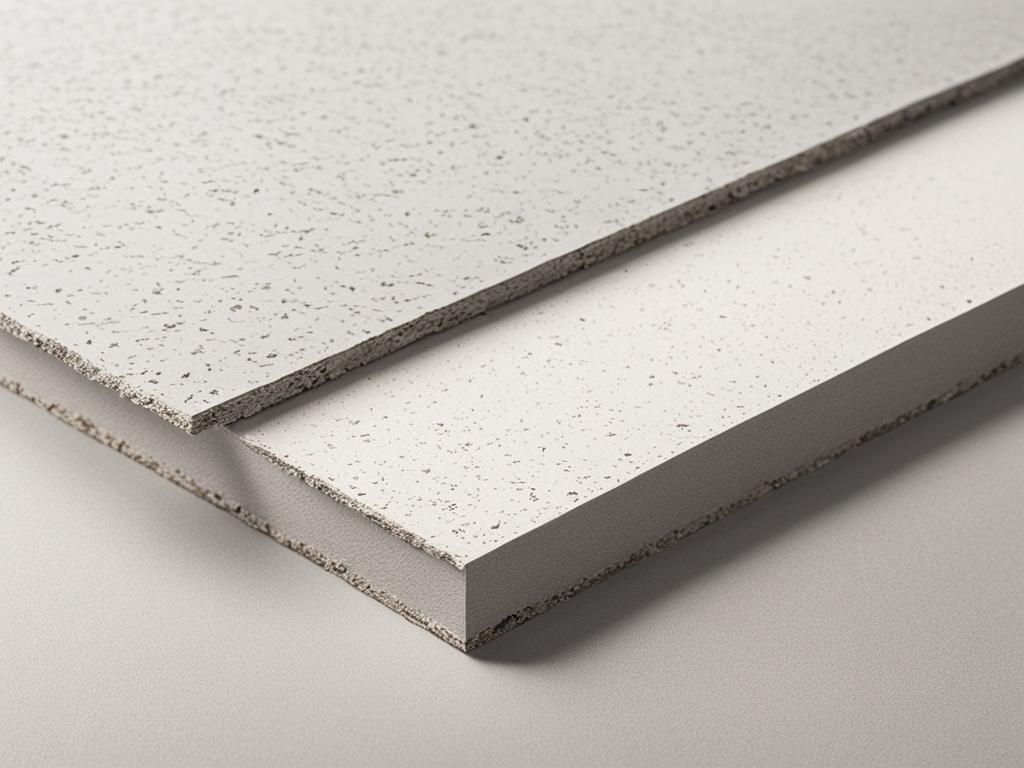Drywall is an essential component of any construction or renovation project, but choosing the right thickness can make a significant difference in the outcome. Two common thickness options are 3/8 inch and 1/2 inch. Understanding the differences between them and knowing when to use each can help you achieve the best results.
3/8 inch drywall is lighter and more flexible, making it suitable for unique applications such as curved walls or repairing small patches. On the other hand, 1/2 inch drywall is the go-to choice for most residential walls and ceilings due to its strength and versatility.
Let’s dive deeper into the pros and cons of each thickness to help you make an informed decision for your next project.
Key Takeaways:
- 3/8 inch drywall is lighter and more flexible, making it ideal for curved walls and small patches.
- 1/2 inch drywall is stronger, more versatile, and commonly used for residential walls and ceilings.
- Consider project requirements, budget, and desired properties when choosing between the two thicknesses.
- 3/8 inch drywall may not provide sufficient soundproofing or fire resistance compared to 1/2 inch drywall.
- Both thicknesses have their own benefits and applications, so choose according to your specific needs.
Pros and Cons of 3/8-Inch Drywall
When it comes to drywall thickness, 3/8 inch offers a unique set of benefits and drawbacks. Understanding the pros and cons of 3/8-inch drywall can help you determine whether it is the right choice for your project.
Benefits of 3/8 Inch Drywall
- Lightweight and Easy to Handle: 3/8 inch drywall is significantly lighter than its counterparts, making it easier to transport, maneuver, and install.
- Flexible and Versatile: Its thin profile allows for greater flexibility, making it ideal for curved walls and areas where more rigid drywall might not be suitable.
- Simple to Cut and Manipulate: The thinner thickness makes 3/8 inch drywall easier to cut and shape, making it a convenient choice for repair work or smaller projects.
Drawbacks of 3/8 Inch Drywall
- Less Strength and Durability: Compared to thicker drywall options like 1/2 inch, 3/8 inch drywall is not as strong and may be more prone to damage.
- Inadequate Soundproofing: Due to its thinner profile, 3/8 inch drywall offers limited soundproofing capabilities and may not be the best choice for areas where noise reduction is a priority.
- Lower Fire Resistance: Similarly, 3/8 inch drywall may have reduced fire-resistant properties compared to thicker options, potentially impacting safety in certain applications.

Despite its limitations, 3/8 inch drywall has its place in specific projects. Consider using 3/8 inch drywall for smaller renovations, areas with curved walls, or situations where weight and flexibility are important factors.
| Pros | Cons | |
|---|---|---|
| Benefits of 3/8 Inch Drywall | Lightweight and easy to handle Flexible and versatile Simple to cut and manipulate |
Less strength and durability Inadequate soundproofing Lower fire resistance |
Pros and Cons of 1/2-Inch Drywall
When it comes to choosing the right drywall thickness for your project, 1/2 inch drywall offers a range of advantages and considerations to keep in mind.
One of the key benefits of 1/2 inch drywall is its superior strength and durability. This makes it a great choice for walls and ceilings in residential spaces, providing a sturdy surface that can withstand everyday wear and tear. Additionally, the added thickness of 1/2 inch drywall offers better soundproofing properties, helping to reduce noise transmission between rooms.
Furthermore, 1/2 inch drywall is known for its excellent fire resistance. Its thicker composition provides a higher level of fire protection compared to 3/8 inch drywall, making it an ideal choice for enhancing safety in your home.
However, it’s important to be aware that 1/2 inch drywall does have a few drawbacks. It is slightly heavier than 3/8 inch drywall, which can make installation more labor-intensive. Additionally, the increased thickness of 1/2 inch drywall means it comes at a higher cost compared to thinner options.
Considering these factors, 1/2 inch drywall is best suited for projects where strength, noise reduction, and fire safety are key priorities. Whether you’re constructing new walls or renovating existing spaces, 1/2 inch drywall provides the strength and versatility you need to create a durable and secure environment.
FAQ
What is the difference between 3/8 inch and 1/2 inch drywall?
The main difference lies in their thickness. 3/8 inch drywall is lighter and more flexible, making it suitable for curved walls and repair work. On the other hand, 1/2 inch drywall is commonly used for walls and ceilings in residential spaces due to its strength and versatility.
When should I use 3/8 inch drywall?
3/8 inch drywall is best suited for projects where weight and flexibility are important, such as small renovations or areas where curved walls are desired.
When should I use 1/2 inch drywall?
1/2 inch drywall is recommended for projects where strength, noise reduction, and fire safety are important considerations. It is commonly used for walls and ceilings in residential spaces.
What are the pros and cons of 3/8 inch drywall?
The advantages of 3/8 inch drywall include its lightweight design, easier handling and installation, and its suitability for curved walls and repair work. However, it is not as strong as 1/2 inch drywall and may not provide sufficient soundproofing or fire resistance.
What are the pros and cons of 1/2 inch drywall?
The benefits of 1/2 inch drywall include its strength, durability, better soundproofing, and improved fire resistance properties compared to 3/8 inch drywall. However, it is slightly heavier and more expensive.
How do I choose the right drywall thickness?
When choosing between 3/8 inch and 1/2 inch drywall, consider factors such as project requirements, budget, and desired properties. If weight and flexibility are important, opt for 3/8 inch drywall. For strength, noise reduction, and fire safety, choose 1/2 inch drywall.
